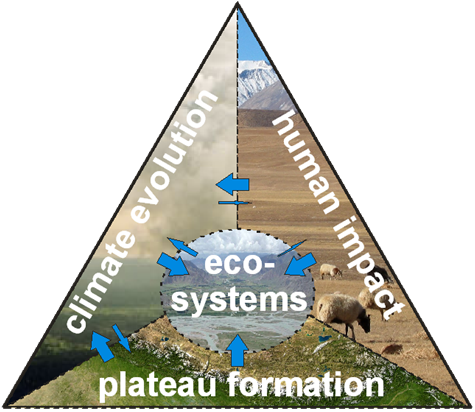Master Thesis
Analysis of the productivity of Kobresia pygmaea pastures on the Tibetan Plateau
Sabrina Träger (07/2011-09/2012)
Support: Karsten Wesche, Elke Seeber
Alpine grasslands of the Tibetan Plateau (TP) play an important role in the regional hydrological cycle and, with their considerable CO2 fixation potential, the global climate (for which the TP is sometimes called “The Earth’s third pole”). Intense grazing has led to severe degradation of this vegetation type in the last decades, threatening ecosystem functioning and the global climate regime. Moreover, it is assumed that the system is nutrient limited which could further impede its regeneration. Therefore, I analyzed the productivity of Kobresia pygmaea grasslands on the TP with respect to nutrient limitation. To identify the main limiting nutrients I conducted a fertilization experiment at two different altitudes (3400 and 4500 m a.s.l.) and on two different pasture types (Kobresia pygmaea dominated and degraded). The experiment consisted of a block design with randomly distributed fertilization plots receiving nitrogen, phosphate, a nitrogen-phosphate mixture and a water control treatment. In addition, the idea of using biochar to improve soil quality was tested by producing biochar from yak manure in a home-made pyrolysis oven and investigating its effect on soil quality and degradation. The results suggest that the Tibetan grasslands are nutrient limited with nitrogen being the main limiting factor. Nitrogen addition increased the biomass production by up to 39 % as compared to the control. The combination of nitrogen and phosphor showed a comparable positive influence on the biomass production of alpine meadows. Species richness, composition and cover were not changed after nutrient application, arguably due to the insufficiently long observation times. The plant nutrient content was strongly affected by different fertilizers but no general pattern could be deduced. Within the experimental time, the forage quality, determined by the nutrient content, was slightly increased by nitrogen and mixed nitrogen-phosphate fertilization, thus confirming the initial hypothesis. Contrary to expectations, forage quality was not found to be higher on Kobresia pygmaea dominated sites than on degraded pastures. Application of 500 g biochar per m2 showed a positive impact on the soil quality of Tibetan meadows. Thus, biochar seems to be a promising candidate and a good alternative to expensive chemical fertilizers for counteracting degradation phenomena on the TP. Moreover since the greenhouse experiment has shown that increasing the biochar concentration does not lead to an increase in biomass production, it is feasible that in real-life applications a much lower concentration could be sufficient. While the results of the fertilization experiment provide an answer to a fundamental question of nutrient limitation in the productivity of the grasslands on the TP, a global application of chemical fertilizers to improve the productivity of pastures in such world regions as Tibet seems economically unrealistic and can even have a negative impact on the ecological balance of locally established and adapted biosystems. Thus a more ecologically and economically viable strategy is needed to actually counteract the overgrazing-induced degradation and nutrient loss of the TP pastures. The introduced concept of biochar as soil-improver is one such strategy.

